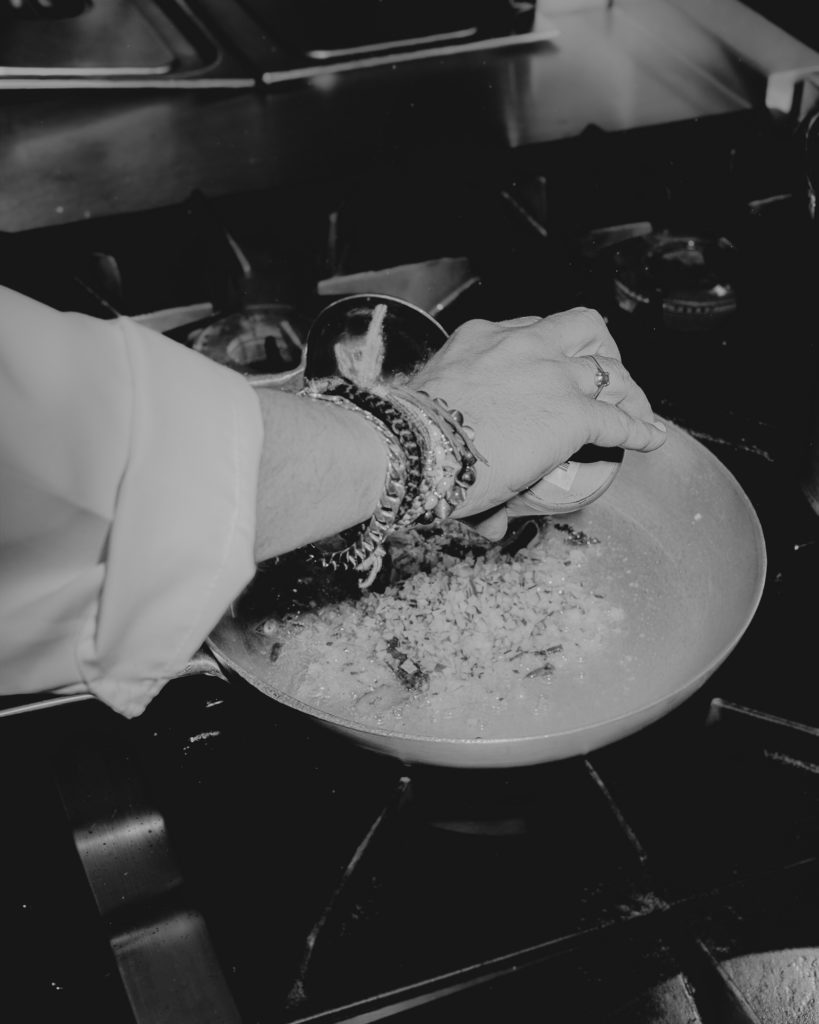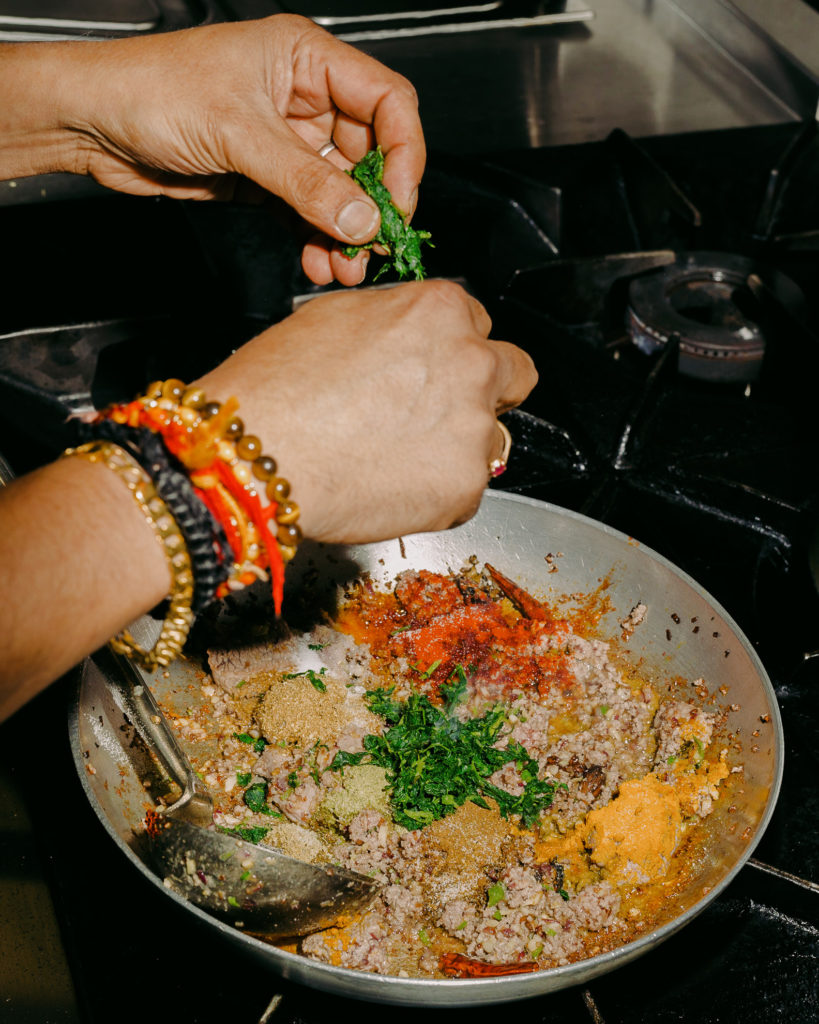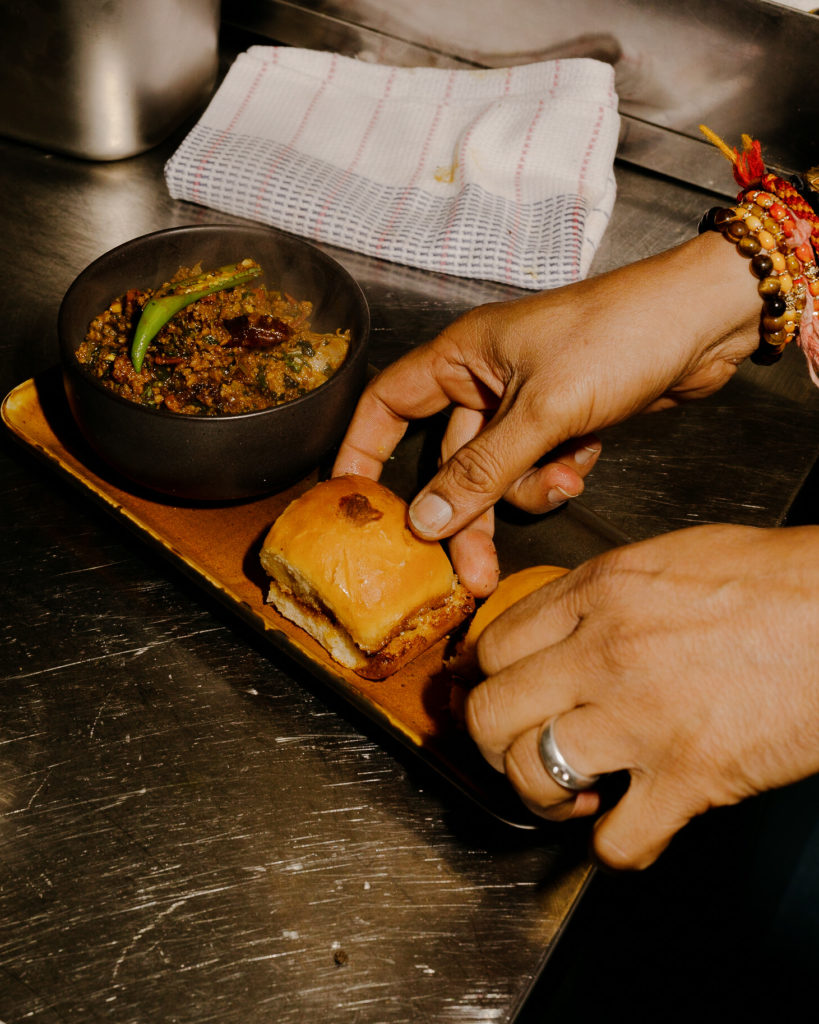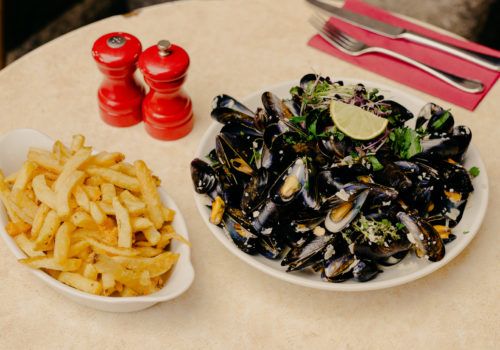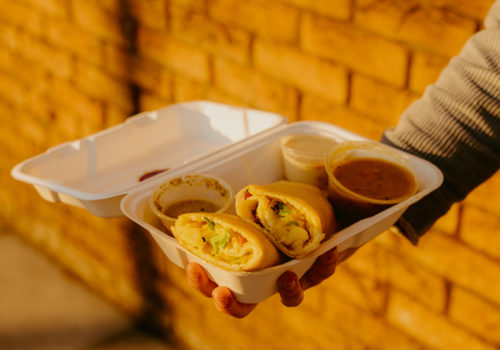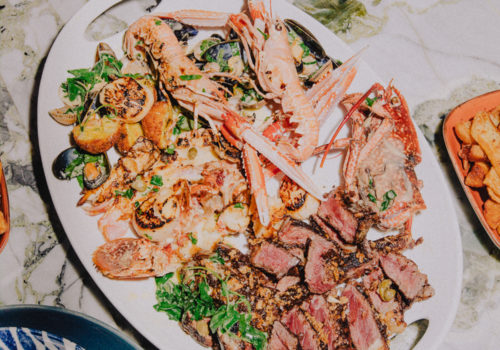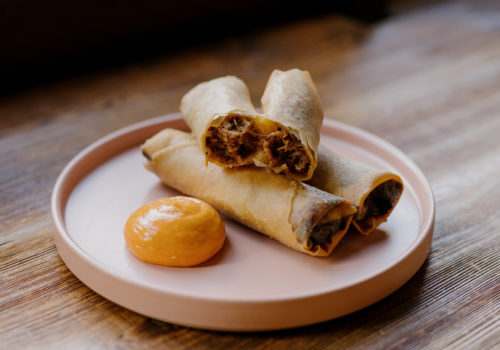Signature Dish: Pickle’s Goat Keema Curry
Words: Emily Mullen
Photography: George Voronov
As intrinsic to Camden street as the broken borders of cycle lanes and the crooked footpaths is Pickle. Which quietly sits on the curve of the road at the Bleeding Horse end, discreet and unassuming. The word Pickle is picked out in burnished gold above the understated green front. Unofficially regarded as the best Indian restaurant in the city, Pickle has helped to recalibrate our attitude towards Indian cooking, taking it out of a plastic container and onto a beaten silver tray.
Opened in 2016 by Benny Jacob and chef Sunil Ghai, with a menu of high-end North Indian dishes. Each dish is steeped in Sunil’s personal history, recipes that have followed him from his journey to Ireland and his trips back home. Starting Pickle after years of working in high-end restaurants and five-star hotels around the world, Sunil was finally able to craft his own menu and he made it personal. Informed by the dishes he associated with his home in the Central Indian city of Gwalior and time spent manning top-class kitchens, Pickle’s menu has introduced countless ingredients, concepts and North Indian dishes to Irish audiences. Choosing authentic dishes that did not cow to the perceived “western” notions of Indian cooking was extremely important to Sunil.
In his freshly starched whites, Sunil commands the shining stainless steel kitchen. There’s an easy confidence and a distinctness that Sunil has somehow imparted into this space. The ingredients for the goat keema curry are laid out in neat piles on trays, the dried spices neatly ordered in a masala box.
As the oil heats in the pan, Sunil gives some mace, star anise, black and green cardamom, a few bay leaves and cinnamon bark and kalpasi [stone moss] a smash in a pestle and mortar. Tipping them into the pan, Sunil waits for the “aroma to arrive” before tipping in chopped red onion, garlic, ginger and freshly chopped tomatoes, joined a short time later by the goat which has been minced and cut into chunks. Fresh fenugreek is added and a few scoops of hot water is ladled on top. Quick to cook, it needs to be prepared well in advance, 48 hours to be exact, in order for the flavours to meld, mesh and almost preserve together. Gesturing at the curry Sunil tells us “you can’t eat it now but it will be horrible”. When the time comes the curry is decorated with lime, onion and completed while the rolls of maska pao bread, which has been cut in half and fried in butter till golden. The plating is simple, intuitive, the slice of lemon placed beside curry, the bread on the tray, it’s important for Sunil that the dish is easy to read for the customer.

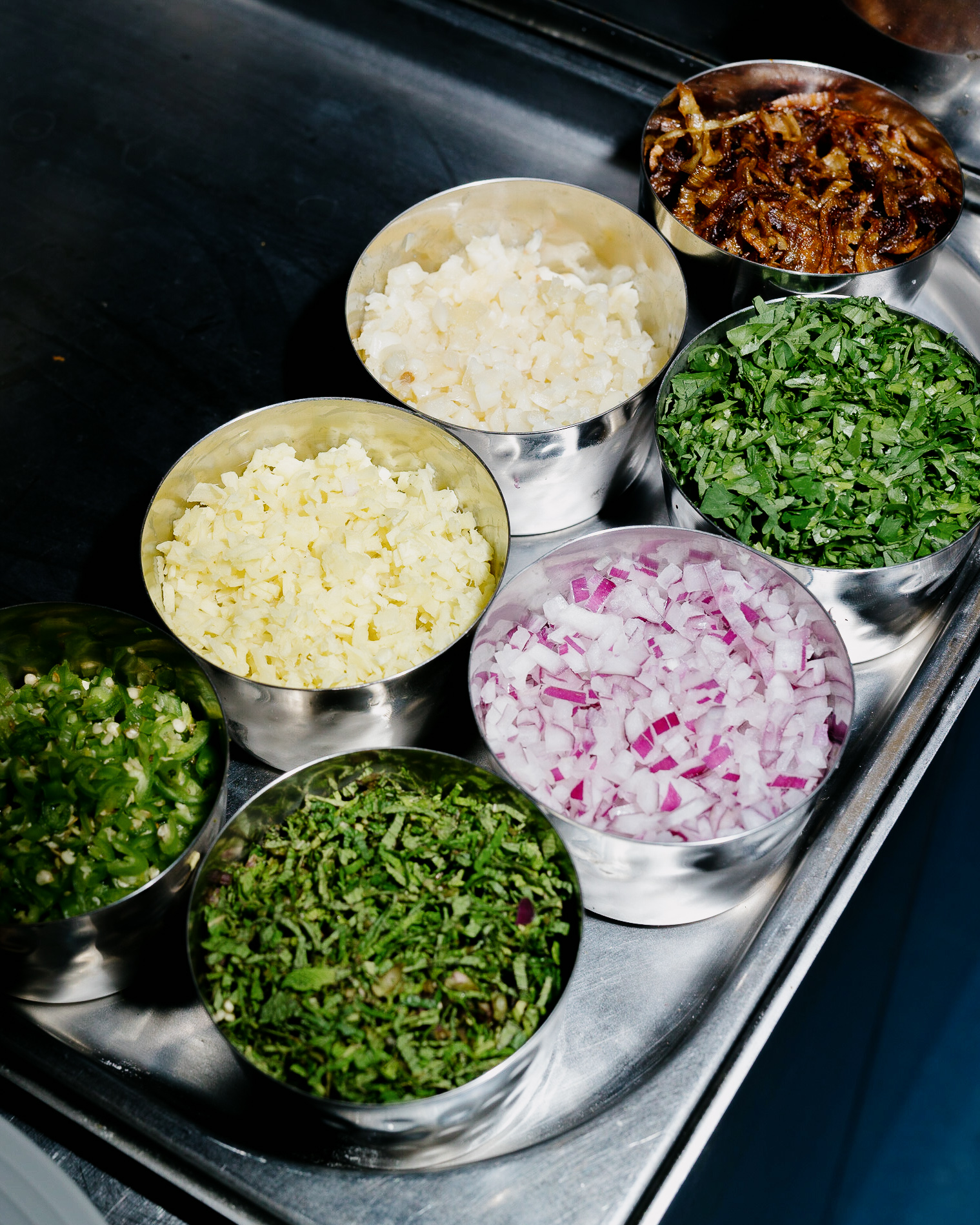
In those 48 hours, the mixture has formed itself into a curry, the mince has all but dissolved into a thick sauce and the chunks have reduced into meaty strips. It’s a rich curry, more reminiscent of a meat like beef or wild boar rather than goat. But in that lies the talent of Sunil to take an overlooked meat like goat and transform it into an unctuous and decadent dish. The bitterness of the fresh fenugreek is the abiding flavour, adding in-depth and a slight sharpness that cuts through the richness of it. It’s got a serious kick to it, the dish comes with a waiter’s warning “if you are able for it it’s on the hot-to-medium scale” the heat is by design the same as it would be in India, pretty hot. A proud proponent of North Indian cuisine, Pickle’s goat keema curry is a distillation of Sunil’s ethos. A daring dish by Western standards, cooked authentically and presented without apologies.
He still turns to his Mother for advice and recipes, even now with three places to his name, Tiffin in Greystones and Street in Farranboley. As a kid with little interest in school, his mother taught him how to cook, he would act as her sous chef, helping to select vegetables from the market, carrying bags, peeling and chopping ingredients for her as she cooked for their large extended family, with dinners set for 17 or 18 people each day. When he was a teenager something clicked with him and cooking and he catapulted into the world of food, working his way up the ranks through countless five-star hotels around India. “A kind of headhunting” brought him to Ireland in 2000, into the kitchens of Jaipur in Dalkey to be specific. There he worked his way up to executive chef of Jaipur Restaurant Group, where he won countless awards and garnered plenty of acclaim. But Sunil got to the stage where he began to ask himself “what’s next?”. Opening Pickle was the answer, but it’s a question that keeps reoccurring for him, as he discusses plans to open a fourth premises in the coming months:
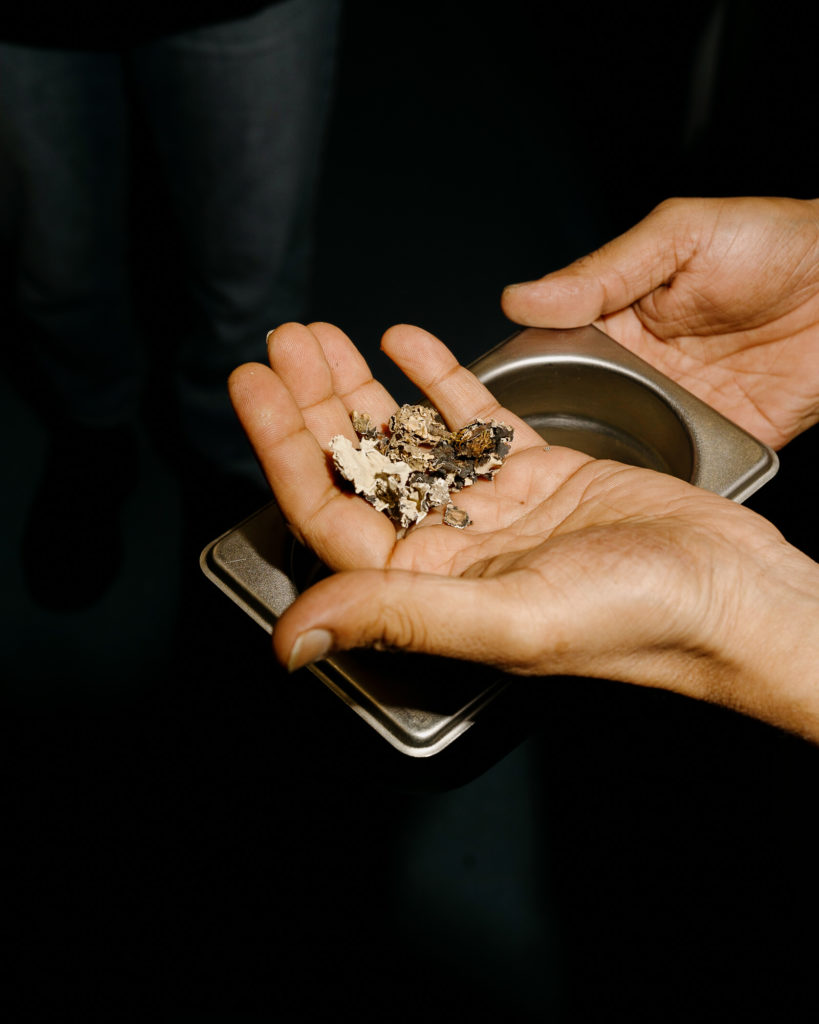
People do use us as a benchmark we feel proud that people like to recreate our dishes when we see them on social channels.
Sunil Ghai
Tell me about the curry?
It’s called the goat curry, it’s very popular now but it was a struggle in the beginning. The spices that we use, you would mostly find in Rajasthan. There are different types of red chilli, that are used in different regions, Rajasthan has three or four different types of chillis which are totally lost now, no one really uses them. So we try to get hold of them sometimes, that’s one key ingredient. The second key ingredient is a moss called kalpasi, it grows near the water. It’s a spice I started bringing from India in 2016 and now you will see a lot of Indian restaurants portraiting it because we started using it. People do use us as a benchmark, whatever I do today you’ll see tomorrow in somebody’s restaurant on somebody’s Instagram where they are trying to recreate it. I hate it sometimes but I take pride in it too that somebody is following me.
It is traditional to have it with bread?
Yes, not with rice. We make all the bread in house with a tandoori oven.
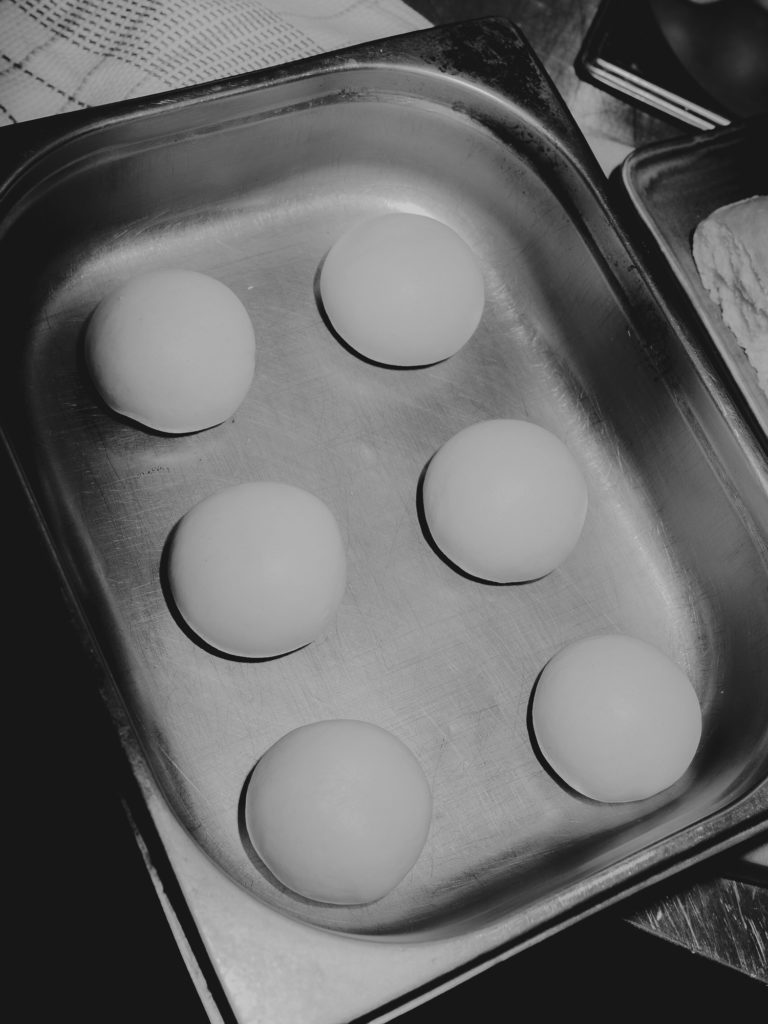

Where do you get your goat from?
This is from Roscommon, the supplier brings the goat to the door. It’s local, you don’t have to wait, you tell them what you need at whatever time and it comes, it’s more personal.
Is it difficult to get goat in Ireland?
It’s just expensive, it’s maybe double the cost of lamb.
Do you go for a specific breed of goat?
This is a rare breed, we go for a free-range, milk-fed goat. They aren’t very big, the supplier doesn’t let them grow too much, so they are pretty small.
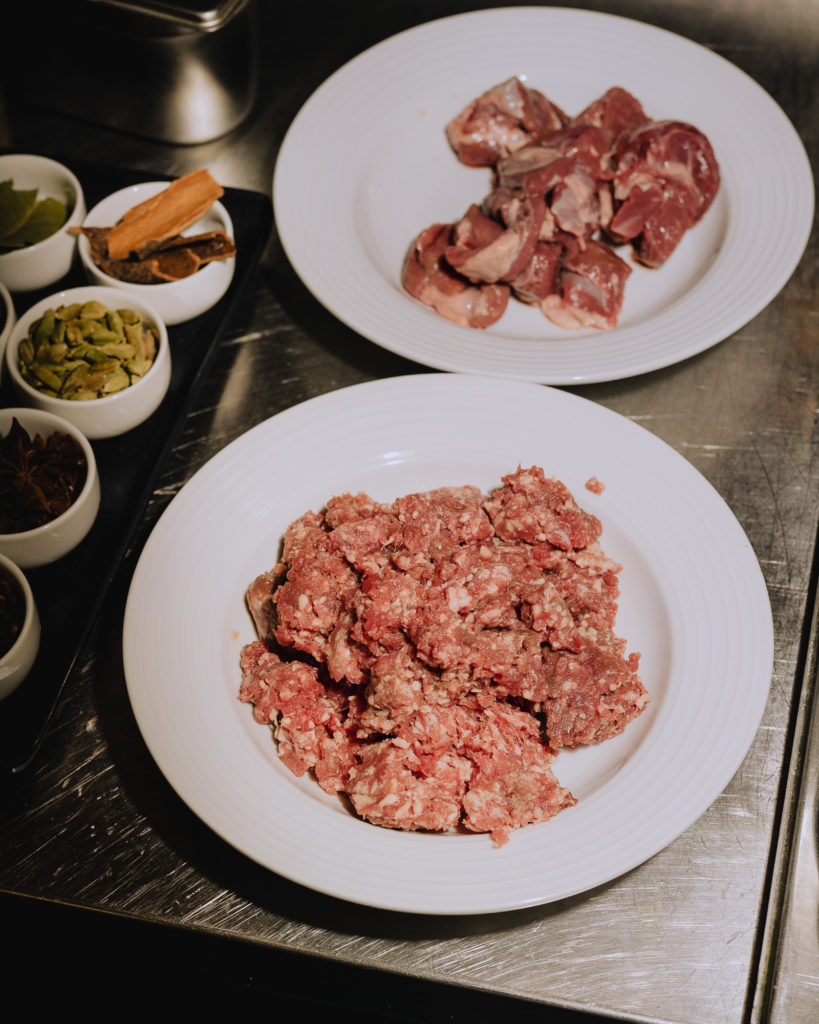
You do seem to place an emphasis on kalpasi, as one of the key ingredients?
It’s called stone flower back home, we were cooking meat on the stone maybe 50 years ago, that was nothing new for us. This was the flower that we used to marinate lamb, there’s even a special kabab back home which is always on the menu which is called a patther kabab which uses this.
Is this something that you make yourself at home?
In terms of meat no, we are a very traditional family. My wife, my mother my whole family are both very traditional, so it gets very difficult. We don’t eat any meat at home, most of the time we eat vegetarian.
Do you cook by order or do you cook in big portions?
If you are cooking something like lamb, the curries taste a lot better when they are old, the next day. The principle that I follow, it has to be at least 48 hours aged curry. If I cook lamb just now, and serve you outside it won’t taste nice. The juices won’t go through the pieces of meat, so it’s always better when it’s older and that’s what we follow. If we sell lamb today and it’s finished, you will not be able to buy it until tomorrow, that’s why we always have some in backup ready, that’s been made 48 hours in advance. But chicken, prawns and fish can be cooked on the day but we have our own basic sauces ready that’s the key of Indian food.

By basic sauces what do you mean?
My problem is that most restaurants here try to cook one pot of curry and then finish it differently for each dish. We don’t do that, I don’t like to follow that route, it doesn’t work that way, you have one bottle and you make ten sauces out of it.
How many sauces do you make at Pickle?
For example at Street, we make over nine different sauces for a takeaway menu. That’s what matters and that’s what makes us different from others.
My problem is that most restaurants here try to cook one pot of curry and then finish it differently for each dish
Sunil Ghai
Are these restaurants that are doing this?
Yes, I won’t name names but they use a “curry sauce” for everything, that’s why curry sauce is so popular, which everybody knows. The minute you enter into an Indian restaurant your perception is that you’ll have a curry and a beer. When I came here, the weirdest thing I had ever heard was the curry and chips thing. Putting chips with curry is the strangest thing, because curry is a sauce. If you go back to my house in India, and my mother is serving you some food and you ask “what curry is that?” she would go crazy about it. Curry is a vegetable or meat cooked in sauce, chicken, lamb curry that’s what it is. There is nothing called curry sauce.
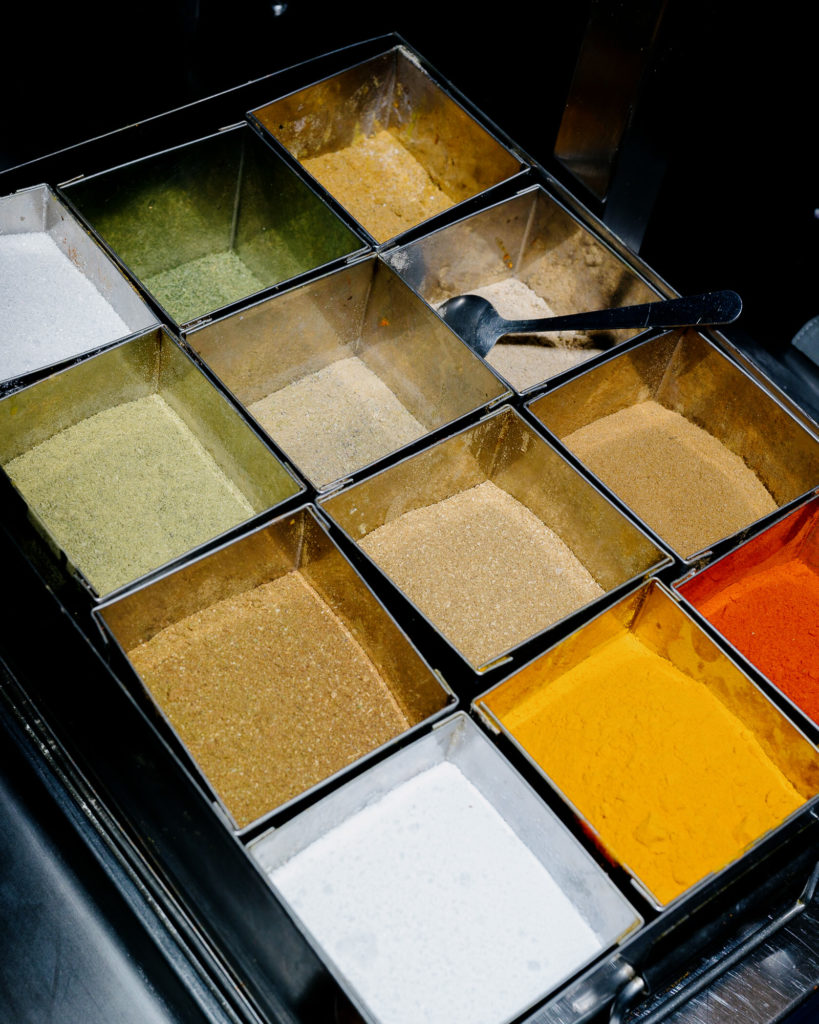
I have heard that you don’t like your dishes referred to as curries?
It’s not about what’s to my liking it’s about taking pride in what you do. I’ve been working since 1992 and I still don’t say that I know everything about Indian food, it’s impossible it’s such a big country. Every hundred kilometres you travel, the way of speaking, the clothes, the way people look, the way we eat, the way the food is, everything changes. So how can you learn everything? It’s impossible. That’s why we try to bring people from different regions into our kitchen, so we learn more from them. Indian food is blessed and people have only seen a very small window of Indian food so far, places like Assam, Darjeeling most of the Eastern belt, food from there is still not on the menus. There’s a lot of poverty that side, it’s not very rich, they are farmers they grow rice and stuff, their food is like water, thin sauces because they want to fill up the bellies with very little meat. Their curries are very thin, there are no kormas in the East, it’s because they can’t afford to have nuts in their sauces. That side is still untouched over there, nobody has seen that side of cuisine.
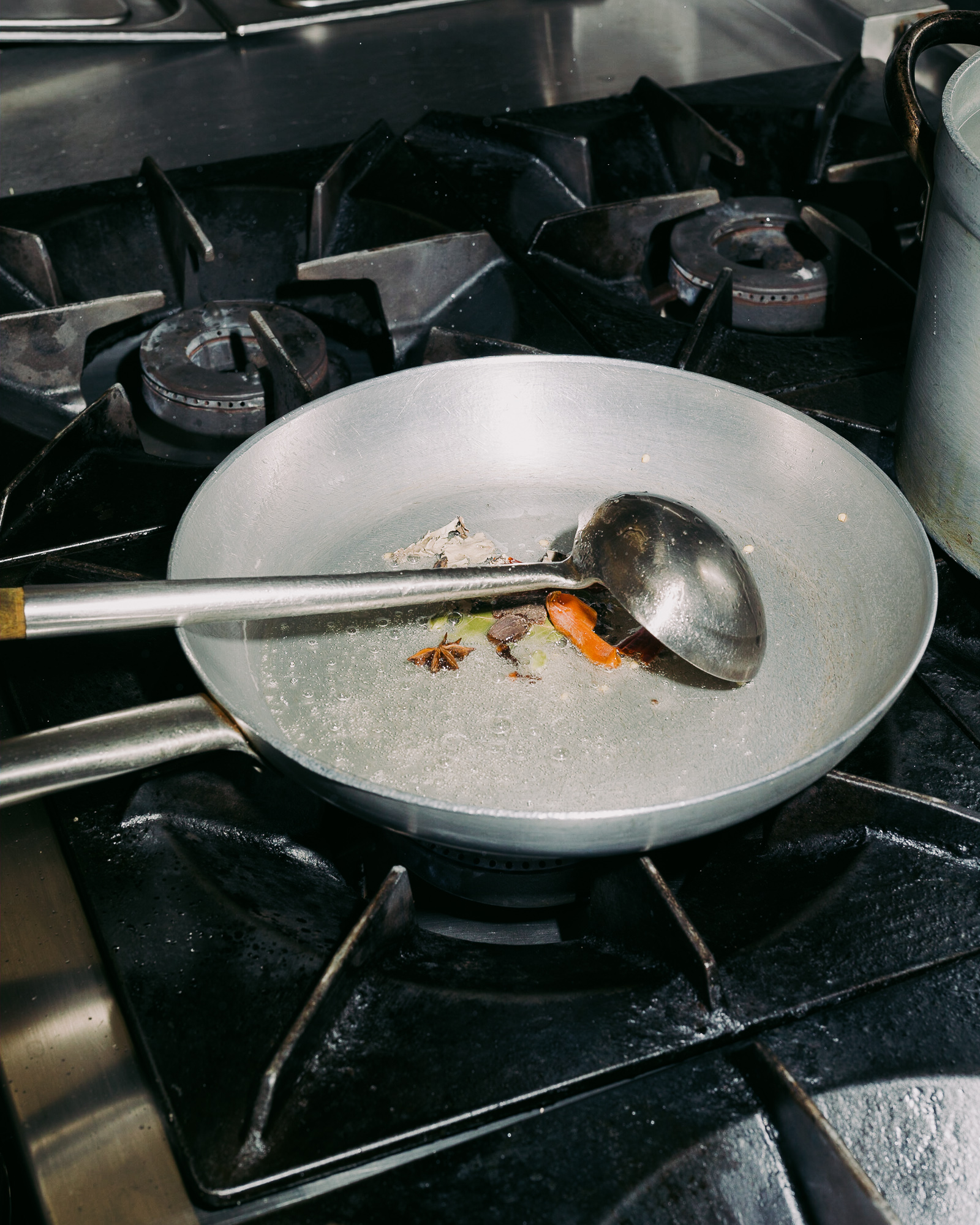

You are seen as someone that has changed people’s perception of North Indian cuisine
I am from the North, when we were opening Pickle my first restaurant with my business partner Benny, I thought “I have to cook what I know”. I don’t have to portray that I know this or I know that, I worked off my own memories of cooking at home, my mother’s recipes. That’s what happened with Pickle’s menu, when we opened a lot of people said “why are you doing North Indian food? It won’t be nice” and I said no and focused on what I already knew. And it turned into one of the first restaurants to focus on one Indian regional cuisine. People still come and ask for their favourite like chicken chettinad( madras) and we just say sorry we don’t do that dish. The difference between a butter chicken and a chicken chettinad, those are two different recipes, one comes from the South and that’s why I won’t do it. [Butter chicken] It’s something that I know that I don’t know, we do chicken Chettinad here and it’s perfect. At Street, I wanted to bring four different streets of India into one plate but keeping the menu very, very small. We only have ten different curries, we have the dishes served on the railways, I chose them because they are memories to me. There are two different ways to cook, one from passion and the other for money. Say this kitchen [in Street] you wouldn’t find a kitchen like this even in some restaurants, here we only seat 10 people. But I don’t like calling my places takeaways, yes we do takeaways but look at the quality, the service here, the suppliers that we use, it’s much more than a “takeaway”.
I don’t like calling my places takeaways, yes we do takeaways but look at the quality, the service here, the suppliers that we use, it’s much more than a “takeaway”.
Sunil Ghai
Is it important to you to make your dishes as authentic as possible?
We try to keep the level of spice the same as back home, if somebody doesn’t like it then they just tell us and we tone it down a little. There are some things that we changed slightly like the Shimla goat curry, they use a lot of ghee in it, so the oil floats to the top so we have reduced that a little bit, but the rest of it is the same.
The name “Pickle” is a bit of an homage to your Mother?
We were struggling over the name of the restaurant, we had over a 100 to 150 names. We wanted something which is easy to remember, something which will gel with my food, that’s why I chose an international name, that’s clear. Pickle is very associated with our food, I was having a meal and I was talking with my wife and my mother over the phone and I thought pickle is something we always have with our meals and this will suit my style of cooking.
It’s interesting how prevalent pickles are in Indian cuisine, but there are very few pickles served here
Even in Indian restaurants, people were not even serving pickle, until we opened and started serving pickles. Now you see a lot of Indian restaurants’ with pickles on their menus. I am happy to see a lot of pickles on the Irish culinary map.
Was it crazy to you when you first started that people weren’t including the likes of pickles on their menus?
People had no understanding, restauranteurs and even Indian chefs never thought of serving pickle. You need to understand why and how it has to be done. There’s a bit of education that you have to do with people all the time, educating people of what your food is all about, why you eat this, why is this on the plate. If you back to say twenty years ago, we were working in Oberoi working in 5-star hotels, we used to go out and meet guests in the restaurant, talk to them about what they liked, what they didn’t, asking them about the food. This was not happening then, none of the chefs, especially in Indian restaurants were going out and meeting the guests, that was the first time a lot of people had seen that and they would ask “what is the chef doing outside the kitchen?”. But I was there to check whether they liked their food or not, but that’s what we do, how would I know that my dishes were good enough for you without asking. They might say to the server that it was good, but how was it good? That’s how you will know how you are doing, whether you are doing something right or something wrong.
Your menu in Pickle does seem to contain unusual meats and flavours?
It has to be bold, you have to have bold flavours on your menu. You need to understand where we are, we are in Dublin we are not in India, so I have to use what is locally available in terms of meats, like scallops nobody eats scallops in India, but I have the availability of fresh scallops so why don’t I use them.
Do you ever find it difficult to get specific supplies?
It is hard, but if you get the right importer they can bring you whatever you want. We try to meet our suppliers every month or so, we sit down with them and we tell them what we need for the next menu, because anything new that you bring in it can take up to two months to get because a supplier needs to be found, it needs to be shipped.
How often do you change your menus?
You keep working on the menus, we keep changing the menus, not the full menu but every three or four months I take out 30% of the menu. I never change the meats, I change the preparation of it, so that people feel a little different. What am I going to do if I take out the chicken from the menu? Nothing, we have to have chicken on the menu but the variation can be different, the accompaniments can be more interesting.
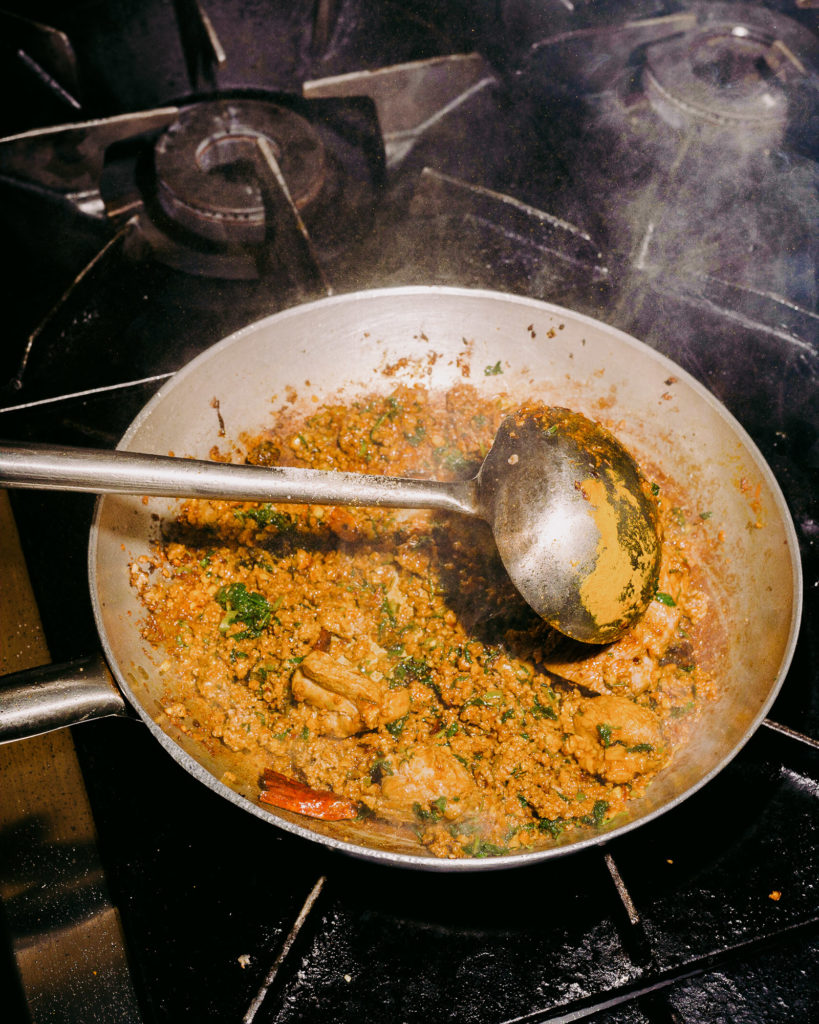
Most of the day I’m in the kitchen, I never leave my pans. I’m not a pen-chef I’m a pan-chef.
Sunil Ghai
How do you come up with new dishes?
Travel, going back home sitting in a street, reading books, and thinking about how to improve things. There’s nothing new happening in the world, everybody is following somebody. Today I cook say the scallops on one side, tomorrow I try and add more spice to it and see what happens, I try to figure out what works and what doesn’t. When I was in college, there was a place called Tekanpur which is a military headquarters, my friend’s father used to be the commander of a unit there. We used to go out there so nobody would catch us going out or doing whatever, there was a small tabard [a small restaurant on the street] we used to eat a chicken and lentil dish, it was so nicely done. I said to myself “I should learn this” the spices, the techniques everything. The guy cooking wasn’t professionally trained or anything he must have seen something at home and has followed it. So I used to change my clothes into something a little torn and then I worked in that place, If I went in a suit they would have never have taught me. I worked there for two weeks, I just wanted to know and to learn.
Does presentation mean a lot to you?
It means a lot, this is where a lot of people go wrong with Indian cooking. Presentation is supposed to be subtle, not all over the place so that people are fighting to eat. It should be nice and clear, I look at the plate and I know to squeeze a lemon on top, to sprinkle some onions over the curry and to eat it with bread.

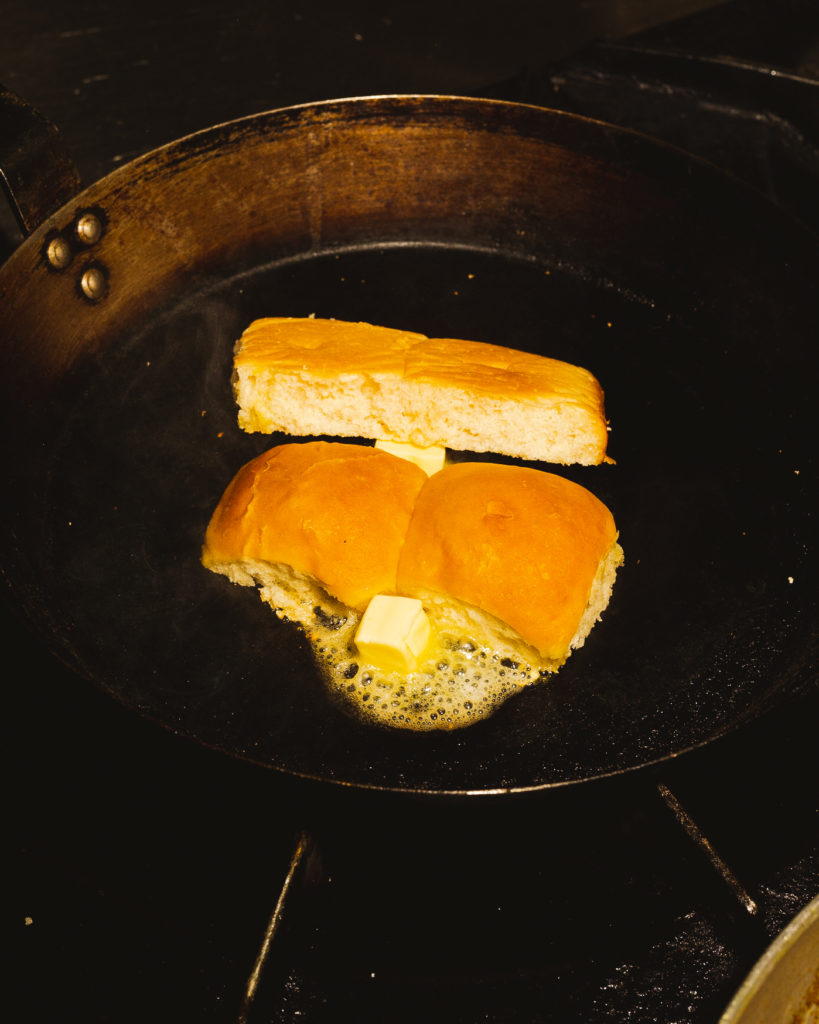
How do you split your time up between your restaurants?
Most of the day I’m in the kitchen, training, meeting with suppliers I never leave my pans. I’m not a pen-chef I’m a pan-chef, I go into the kitchen and I cook every day. I’m in Street for two days, then I’m in Tiffin and Pickle too.
Suppose a lot of people are wondering where your Michelin star is?
Even I am wondering where my shiny twinkle star is! As my late father used to say things will happen when the time is right. Will wait for it …. But I’m happy as long as my seats are full. A Michelin star would bring a lot of positivity and confidence into the team, it will bring a lot of international recognition and by God’s grace, we already have some of that. But I don’t know why they are so difficult here, what they look for I don’t know but one thing is sure we will never give up…..
Where your brother works as a head chef in London has a Michelin star, does he ever slag you about it?
At least we have one star in the family, he’s my younger brother he is five years younger than me so he would never dare to slag me! Ha! He has opened two places in the Middle East, one in Qatar and he is opening one in Doha as well, he has one in London and he is opening a second in Mayfair.
What does your mother think about you and your brother’s culinary success?
The relationship with your mother is one of the simplest in your life. They will do things for you without even asking if you need it. It’s the one relationship in your life that you will never forget and no one will fill that relationship for you, that’s one 24/7 payless job.
Did she teach you how to cook?
There’s no one in our family that is a chef, I started because I was not very academic, I was a bad boy. Then Rohit came along because he saw me cooking and that kickstarted it for him. We come from a very big family, it’s a joint family, my father who passed away last year and his four brothers we used to live together. So my late father was the eldest of the family we have a ritual that the eldest woman of the house, will go to the kitchen first and she will cook the meals for everybody. My mother would manage the kitchen, we had 17/18 people living in the house, a big joint family house, in these houses you only have one kitchen but you have all these different rooms, that’s a belief in Hindu culture that the unity takes place in the kitchen. So my mother used to cook and I was fourth in the family, so I used to sit with her all the time, holding her finger going into the kitchen, seeing her cooking, going to the market, buying vegetables holding a bag with her and she used to take me to the places on the street serving food so I used to eat with her. That’s how this thing started in my mind, and when I was in the equivalent of fifth year I had to do something so I chose food. We were not very rich, with so many people to feed so that was when I went out to work and started earning.
Do you still rely on the recipes your mother taught you?
I still do, and I still ring her for advice, asking her “what did you use in this?” or “how did you used to make this?”.
Did you get headhunted here?
It was headhunting in a different way, one of the executive chefs I had works with knew one of the owners here and they were looking for somebody that’s how I came here. Ireland was never on my map, Australia was there always, I went to Australia from here in 2009 and I still have a Permanent Residency for that country but then I came back. I was there for 20 days to a small festival in Melbourne and then when I came back I got awarded the best chef of the year award by Food & Wine. This is your destiny, whatever happens, happens for a reason. You try to make things go your way but it doesn’t, whatever needs to happen happens.
What are your customers like?
There are people that come from all over the world to try Pickle and book six, seven months in advance, that’s what’s important to me. There are people who come from Bangkok every year, they ring us to book and they say “we are coming and we want that specific table” that’s what you want loyal people.

Would you say Pickle is your favourite?
They are all my favourite! Pickle is my first, but all my places are there for different reasons. They are all feeding somebody and they are all feeding the staff’s families too.
Is Pickle more significant to you because it was your first place after years of working for other people?
I did all I could wherever I worked to make it as good as possible, but you do get to a stage where you ask yourself “what’s next? What is there for me now?”. If you start seeing that the door is getting closer and it’s getting darker you need to open up and bring that little bit of light into your life, and that’s how Pickle started. That’s everybody though, I think 99% of people (and chefs) do want to do something for themselves and do it in their own style. When you work for somebody you do have to listen to them, they might say “I don’t want this candle here I want it here” it might not make any sense to me but it makes sense to them, so you need to listen to them.
Are you more conscious of this kind of logic in your own kitchen?
I always give them open space to showcase their skills. I say to my chefs cook from your heart because the person sitting outside is here with a lot of expectations from the name on the board outside and we have to do our best, that’s it .
Are you planning any more spots?
Always! I am on it, I never say no to anything new. It won’t be happening now but whenever it happens, I always want to bring something new, it is just a matter of getting the right premises and the right location. Cork is always on my map, I always want to do something in Cork. But what I need just isn’t available, the rents are pretty crazy at this stage. You can take anything you want but how you are going to repay it is important. I’m not the kind of person who thinks after two years “ah I’ll close down” that’s not the way to do it, either you do it properly or not at all.
You can find Pickle in Dublin 2’s 43 Camden Street Lower, Tiffin by Sunil in Wicklow’s Greystones and Street on Farranboley’s Bird Ave.
Elsewhere on District: Signature Dish, Chez Max’s Moules-Frites


